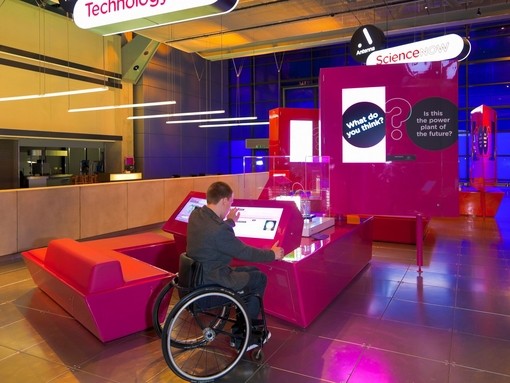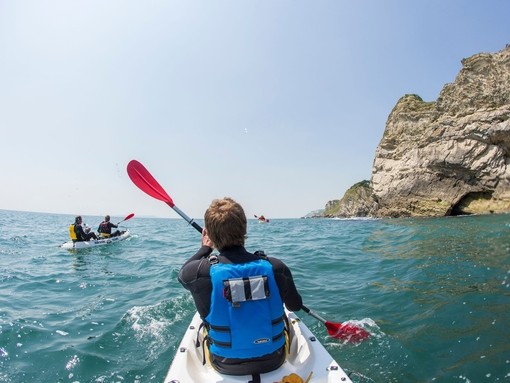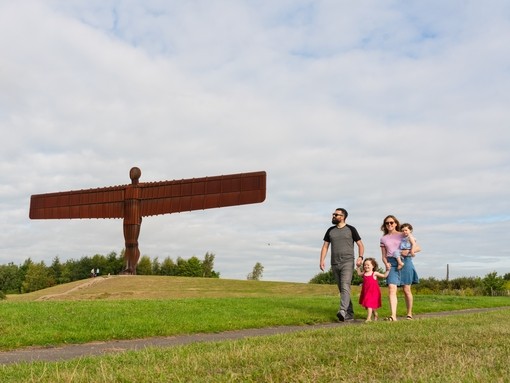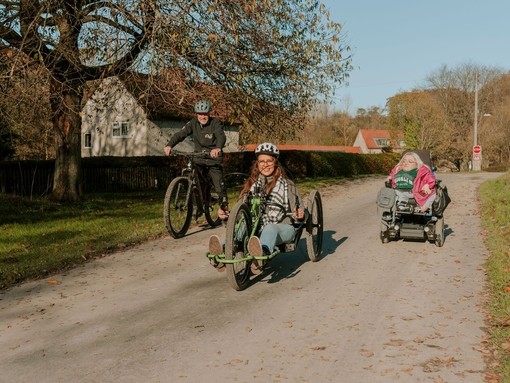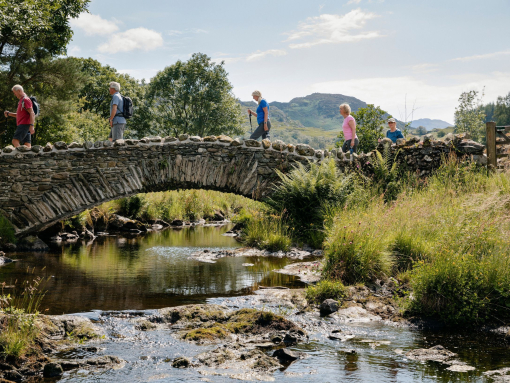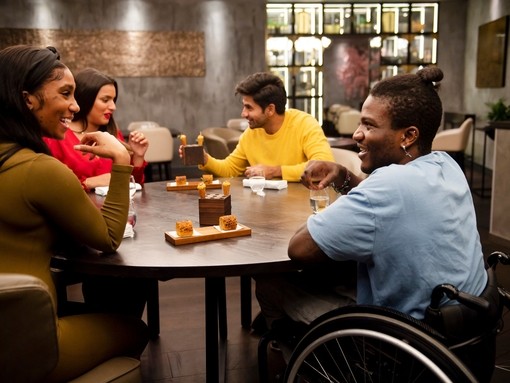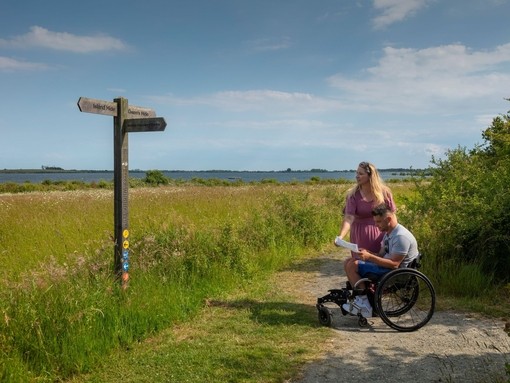Photo by: Visit Kent/Rebecca Douglas
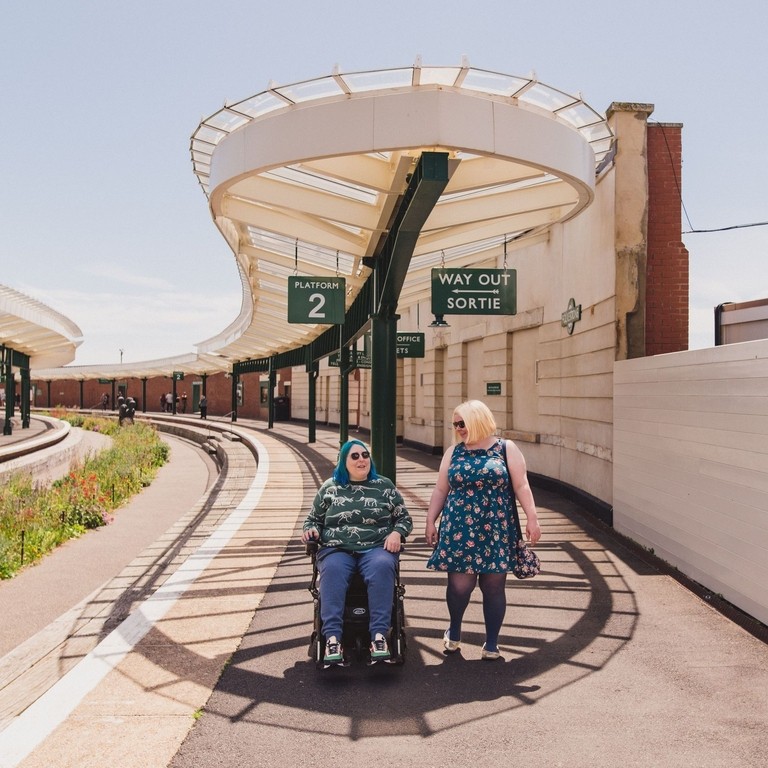
Accessible guide to the south-east of England
Home to two National Parks, the New Forest and the South Downs, there’s plenty of opportunity to get out and about in nature, with access for all trails and accommodation, travel and more.
Accessible travel around the south-east of England
The south-east of England is well connected by train, car, bus and coach travel.
With direct trains from London, getting to the major spots in the South East is easy. Some coastal hotspots, like Brighton, Bournemouth, Margate and Hastings, can be reached within an hour from the capital, and cultural highlights including Winchester in under two hours.
- Covering the south west of the region is South Western Railway.
- The rest of the South East is mainly covered by South Eastern Railway.
- Southern Railway covers the coast through East and West Sussex.
- Great Western Railway run services to the Royal Borough of Windsor.
- Chiltern Railways operate along scenic routes from London Marylebone into the Chilterns, Oxfordshire, Buckinghamshire and Shakespeare country.
- CrossCountry cover cities in the South East.
The south-east of England stretches from the White Cliffs of Dover to the beaches of Bournemouth, Christchurch and Poole and up to the countryside of Oxfordshire and Buckinghamshire. For driving routes see the AA Route Planner with the option to avoid heavy traffic, motorways, tolls and congestion charges.
Driving Miss Daisy offer a nationwide driving service providing extra support to people with health conditions and impairments. There are a number of ‘Daisies’ (drivers) available across the south-east of England to help you explore.
Local companies operate all over the south-east of England, such as Stagecoach. These cover small rural routes and others in more populated areas and are adapted to take wheelchairs. You can also find tour coach companies in the South East with organised trips to places of interest.
Accessible things to do in the south-east of England
Discover our pick of accessible things to do in the south-east of England.
Photo by: Visit Essex/ Rod Edwards
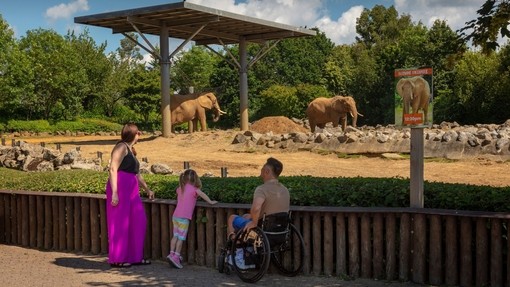
Adventure and sport
From dragons to pirates, explore a whole world in bricks at Legoland, Windsor. Some Legoland rides can accommodate wheelchairs, like the Legoland Express and the Aero Nomad big wheel. You will need to apply for a Legoland Ride Access Pass seven days prior to your arrival. For a calm environment, the park has quiet hours on some days. All toilets are accessible, there are hearing loops and carers can visit for free. For those who find queuing difficult, download the smartphone virtual queuing system. There is also a Sensory Space at Legoland if visitors need some down time.
Take to the air and find a whole new way to discover the South Downs: by paragliding or hang gliding. Introduced by the British Hang Gliding and Paragliding Association, Flyability enables disabled people to enjoy this pastime. If you book a one-off flight, you can do so in a tandem with an instructor, leaving you free to watch the world around you.
Fancy soaring over verdant pastures, even doing the odd loop-the-loop? Aerobility makes it possible. Anyone with any disability can fly here and, if you’re super keen, you can even return and train for a private pilot’s licence. Flights are heavily subsidised in the hope that they don’t have to turn anyone away. Take your choice of a two or four-seater, then once in the air you’re encouraged (by the pilot next to you) to take control. Advance booking is essential.
This accessible boat ride with Wetwheels Solent was created to allow every person the chance to experience the thrill of a speed boat. You can even have a go at being the skipper yourself! Take a quick blast on Gunwharf Quays, along the coast to the mouth of the Beaulieu River. Then, travel slowly up to Buckler’s Hard – originally granted to the monks of Beaulieu Abbey and now a haven for wildlife. Alternatively take a sundown tour, or tour of Chichester. Private tours are also available, including seal safaris, harbour tours and fishing days.
Whether you’re all about rollercoasters or prefer making a splash with water rides, thrills await at Thorpe Park. Apply at least seven days in advance for a Ride Access pass, and reach out to the Accessibility Experience Team before your visit to be provided with a personalised Accessibility Plan for your visit. The Accessibility Kiosk, to the right of the entrance turnstiles, is a useful point of contact for any issues during your visit. Wheelchairs and mobility scooters are welcome, as are guide dogs – although these are not permitted on rides. There is a Changing Places facility in the Upper Dome.
History and Heritage
Just one hour by train from London, Canterbury is a hodgepodge of ancient buildings, a small and lively art scene, and award-winning restaurants. Expect some unevenness from cobbled streets but attractions like the King’s Mile and St Augustine’s Abbey are accessible along with other wheelchair accessible activities. Canterbury Cathedral dates from AD 597 making it the oldest cathedral in England. Though ancient, it has been adapted where possible to become accessible. Wheelchairs can be borrowed at the site and you’ll find lifts, accessible ramps and specialised guided tours, including BSL and tours for people who are D/deaf or hard of hearing. There is also a ‘Touch and Hearing’ model just inside the main entrance.
Take a punt on the waterways of Canterbury and explore the city from the leisurely comfort of your own boat. Canterbury Punting Company has accessible boats, hearing loops and other facilities. The company offers a transfer board system between wheelchair and punt, assisted by staff who are certified in people moving and handling. You can book a shared or private tour to see the city from a whole new perspective.
Explore 300 years of history at the birthplace of Winston Churchill, also the filming location for a James Bond movie. Blenheim Palace is wrapped by acres of landscaped parkland, thanks to 18th-century landscape architect Capability Brown, as well as formal gardens which have an accessible route. Mobility scooters and wheelchairs are available to hire at the Access Desk, there are accessible lifts and ramps throughout the house, assistance and support dogs are welcome, and you can book a touch tour of the Palace.
Leeds Castle is an epic fortress with tales to tell. The castle itself spans back 1,000 years, and you can get around by foot, wheelchair, accessible castle train, ferry boat and mobility bus. It embraces the Sunflower lanyard and is dementia-friendly, too. Inside, there is an accessible route which includes a lift, though some upstairs rooms are not accessible to wheelchair users. Assistance dogs are allowed, there are accessible toilets, parking bays for disabled visitors and more.
Founded in the 11th century, Arundel Castle is now home to the 18th Duke of Norfolk. Taking in impressive views of the South Downs, it’s a picture perfect castle, complete with moat and huge turrets. Access to the castle is through a ramped entrance, and there are access lifts within. Wheelchairs and mobility scooters are welcome. You’ll find accessible toilets inside the castle and on the grounds, the gardens have gravelled footpaths suitable for wheelchairs, and assistance dogs are welcome throughout.
The perfect blend of eccentricity and luxury, Brighton Pavilion exudes the impression of a luxury country pile blended with India’s Taj Mahal. Built by the Prince Regent (later King George IV), its interiors are grandiose and flamboyant (look out for the red-tongued silver dragon chandelier). The upstairs is non-wheelchair accessible but it’s the downstairs that is the jewel of this crown. The ground floor includes an audio-visual room, accessible toilets and tactile tours for visitors who are blind or partially sighted. The gardens have wide tarmacked paths and lawns are generally flat.
Just a few hundred yards away from the Royal Pavilion, there’s the Brighton Museum and Art Gallery, including works by contemporary artist Sir Grayson Perry. The museum is wheelchair accessible and has a passenger lift, accessible toilets and BSL group tours.
Step back in time at the Historic Dockyard Chatham, as you explore its interactive galleries and collections covering hundreds of years of British history. Winner of the Accessible and Inclusive Tourism Gold Award 2024/25 at the Beautiful South Awards, it’s been recognised for its accessibility initiatives including regular Audio Described and British Sign Language tours, a monthly dementia cafe and sensory support backpacks.
Outdoors and nature
Packed with wildlife, the stretches of golden beaches that reach out towards the Isle of Wight and South Downs make this a pretty special place. The Chichester Solar Heritage boats glide silently through this Area of Outstanding Natural Beauty, as the crew point out scenes of wildlife, coastal habitats and historical points. Assistance dogs are allowed and there is a passenger lift. After that, enjoy West Wittering Beach by beach-friendly wheelchair, or head far west to the end of the car park for an 11 mile (17 km) wheelchair accessible cycle path.
The South Downs Way is the first accessible National Trail in the country. With 100 miles (160km) of cross-country or off-road trails, its lush hills and valleys, wild flowers and wildlife are yours to explore. If you want to get off the beaten track, accessible pony trekking in an adapted off-road horse-drawn cart with Pony Axe S is for you.
Set within 22 acres of woodland and wildflower meadow, the resident birds at the Hawk Conservancy Trust, the accessible conservation charity, know how to put on a show. People who are partially sighted or hard of hearing, as well as visitors using wheelchairs or with reduced mobility, have plenty of opportunities to experience coming close to these beautiful birds in three world-class flying displays held every day. Walkways are mostly flat tarmac paths and assistance dogs are allowed. There are large-print menus in the Feathers Restaurant and accessible toilets. Enjoy the daily talks and displays with commentary, or why not book onto a flying experience?
There’s fun for all the family in the varied landscape of the New Forest, where woodlands and heathlands meet the south coast. Get back to nature with PedALL, offering inclusive guided cycling rides through the National Park. Bikes can suit different seating positions, have extra wheels to help stability, and use extra straps and harnesses.
From big cats to minibeasts, Colchester Zoo is a brilliant day out for any animal lover. There is a Changing Places facility, and all other toilet blocks have an accessible toilet facility. There is a wheelchair-accessible carriage on the Lost Madagascar Express road train, a fun way to get around the zoo. A number of staff members have disability awareness and Autism Friendly training and ear defenders can be provided – useful for encountering some of the zoo’s noisier residents, like its lorikeets!
Relaxation and well-being
Soaring high above the harbour in Portsmouth and delivering some pretty awesome views, is the impressive viewing platform of the 170 metre-tall Spinnaker Tower. Built to look like a sail, on a clear day you can see for miles to the Isle of Wight, the South Downs and the New Forest. A high-speed lift hurtles you 100m above sea level to the viewing deck. There’s a glass-floor sky walk and a cafe in the clouds. The highest viewing deck (the Sky Garden) is only accessible by stairs. A hearing loop is available at the main reception and there are accessible toilets on site.
Art and culture
The 19th-century landscape painter J. M. W. Turner was drawn to the light of the sweeping skies during his many visits to Margate. The Turner Contemporary opened its doors in 2011, on the site of the boarding house where he used to stay. The wheelchair accessible museum is packed with fun, interesting and quirky art. There’s an accessible cafe, and just beside the gallery, on the sand outside, is one of a series of one hundred, solid cast-iron figures by artist Antony Gormley. It has step-free access, hearing loops, BSL tours, ear defenders, operates quieter hours and more.
For a great night out at the theatre, look no further than the Brighton Dome. With performances ranging from classical ballet to circus shows, there’s something for every taste. The foyers, ticket offices, bars and auditorium itself are all wheelchair accessible, with lifts to the wheelchair viewing platforms available. From BSL-interpreted and captioned performances to relaxed and chilled shows, the venue aims to widen access to the arts. For audience members with autism spectrum conditions, touch tours of sets, costumes, props and instruments can be arranged.
Shopping
This open-air shopping destination, Bicester Village, in the centre of the rolling Oxfordshire countryside is set out like a village. It features more than 150 boutiques with huge designer labels from Fendi to Givenchy. The boutiques are all accessible by wheelchair and access dogs are welcome. Concierges and hosts are happy to help, wheelchairs can be borrowed and accessible parking is free. For some brands you can also queue digitally.
There’s bags of fun to be had at Bluewater, where you’ll find three flagship stores: Marks & Spencer, John Lewis and House of Fraser. You’re spoilt for choice with restaurants, and there’s even a Showcase Cinema de Lux. There are more than 300 reserved accessible parking spaces, various disabled toilets and two sets of Changing Places facilities. Head to AbilityPlus in the centre’s welcome hall for the hire of mobility scooters, powerchairs and manual wheelchairs. Quiet hours for guests with additional needs are every Tuesday between 4pm and 6pm, with reduced music and dimmed lighting. Sensory backpacks and Hidden Disabilities Sunflower Lanyards are available on-site.
Oxford’s Westgate shopping centre is the place to go for more than 100 brands, plus a charming rooftop dining area and Curzon cinema. There are 50 accessible parking bays and a range of mobility scooters and wheelchairs that are free to hire to get around the site. The centre is fully wheelchair accessible and disabled facilities include a Changing Places toilet on the Roof Terrace. Guests with additional needs can collect a free sensory backpack from Guest Services, which contains a HD lanyard, ear defenders and sensory toys.
Film and TV
Hogwarts awaits at the Warner Bros. Studio Tour London, which offers the ultimate behind-the-scenes peek at the magic of Harry Potter. Both manual and electric wheelchairs are welcome at the Studio Tour. While the majority of the experience is wheelchair-accessible, certain areas are not: these include Diagon Alley’s cobbled street and the Great Hall’s slate floor. Sensory support bags and a sensory room are available for those with additional needs.

